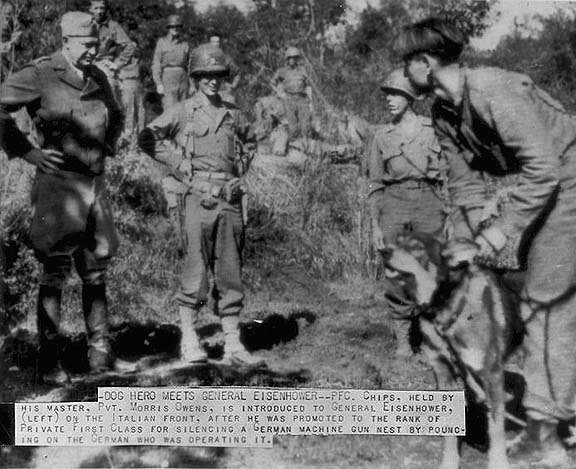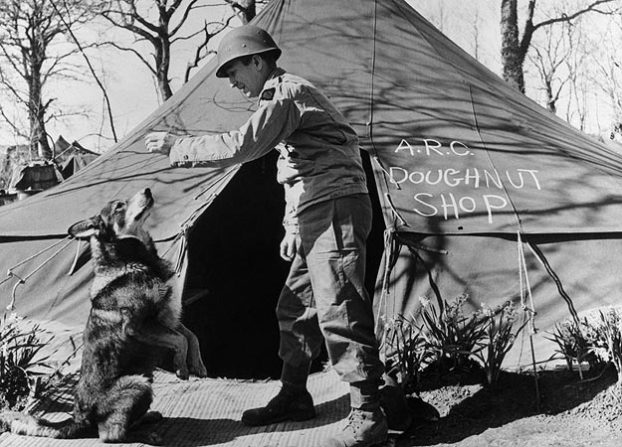US heroes who served in WWII received medals and honors. But one particular national hero’s popularity would bring too much attention and stir controversy. His name was Chips – and he was a dog.
Dogs have been used in combat for ages, just like many other animals. But not until WWII did the US Military form its first canine divisions. After the attack on Pearl Harbor in 1941, a call was issued for patriots to donate their dogs for military training. Tens of thousands responded. Among them was a family from Pleasantville, NY, whose young Shepherd-Collie-Husky mix, named Chips, recently attacked a garbage collector. In 1942, he was sent to the War Training Center in Front Royal, Virginia. Out of 18,000 candidates, 10,000 proved fit to serve. Chips was one of them.
The first of the so-called K-9 Corps were to be used on the home front. But in 1943 fifteen dog platoons were sent overseas. Chips’ first mission was to safeguard the historic Roosevelt-Churchill conference held in Casablanca in January the same year. Later, he traveled to Europe and Africa as a tank guard dog with General Gorge S. Patton’s Seventh Army.
His first heroic deed was to alert his troops of an ambush. After spotting the enemy, he ran back to the base with a telephone cable attached to his collar, so that his platoon could call for backup.
Later that year, he accompanied his handler, Pvt. John P. Rowell, to Sicily. One day, while patrolling the coast they came under enemy fire coming from a nearby bunker. In breach of the service regulations, he broke off from Pvt. Rowell and jumped straight into the bunker. Moments later, several machine-gunners were forced to surrender, bitten and scared to death.
Even though this act of bravery almost cost him his life – his head was wounded by a bullet and skin burned from gunpowder – later that night he was back on duty. This resilience proved invaluable. The very same night he timely spotted a group of 10 Italian soldiers, which allowed his platoon to intercept and capture them.
His actions were already gaining attraction. The very same year he was awarded the Purple Heart and Silver Star. Other medals followed and he came to be the most awarded war dog of WWII. Soon after, the future president, General Eisenhower, demanded to meet him on the front. He probably didn’t expect that the stressed out and well-trained hero will nip his petting hand.

Stories of his valor soon reached US newspapers. In January 1944, The New York Times ran a headline: ‘Army Dog is First to Win DSC Award’. This enraged quite a few important military figures. How could a dog, a part of army ‘equipment’ be awarded medals meant for men? Angry letters were written and the case soon reached the Congress. Three months of debate resulted in a decision to stop awarding the heroic canines. Chips and other war dogs were stripped of their medals.
Nevertheless, the men of his 3rd Infantry Division unofficially awarded him a Theatre Ribbon with arrowhead and eight battle stars. Seven months upon returning home in 1945, Chips succumbed to injuries he sustained during his service.
Political decisions didn’t make Chips any less of a legend. In 1990, Disney produced a movie “Chips, the War Dog”, engraving him in the hearts and minds of many. The debate surrounding Chips’ case drew attention to the role and treatment of canines in combat, reaching a peak in the aftermath of Vietnam when many dogs were left behind with the rest of ‘equipment’. Nowadays there are countless memorials across US dedicated to K-9 dogs.
